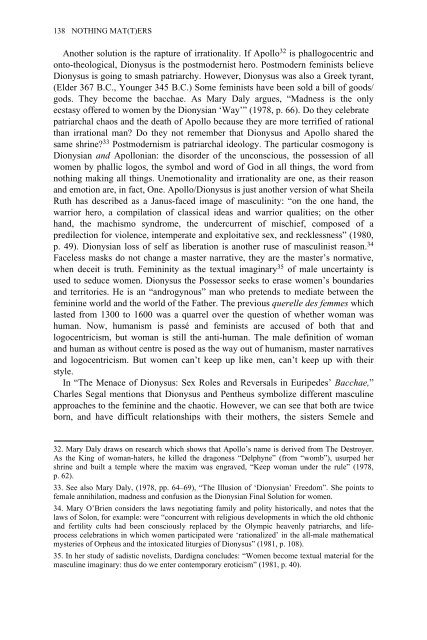Nothing Mat(t)ers: A Feminist Critique of Postmodernism
Nothing Mat(t)ers: A Feminist Critique of Postmodernism
Nothing Mat(t)ers: A Feminist Critique of Postmodernism
You also want an ePaper? Increase the reach of your titles
YUMPU automatically turns print PDFs into web optimized ePapers that Google loves.
138 NOTHING MAT(T)ERS<br />
Another solution is the rapture <strong>of</strong> irrationality. If Apollo 32 is phallogocentric and<br />
onto-theological, Dionysus is the postmodernist hero. Postmodern feminists believe<br />
Dionysus is going to smash patriarchy. However, Dionysus was also a Greek tyrant,<br />
(Elder 367 B.C., Younger 345 B.C.) Some feminists have been sold a bill <strong>of</strong> goods/<br />
gods. They become the bacchae. As Mary Daly argues, “Madness is the only<br />
ecstasy <strong>of</strong>fered to women by the Dionysian ‘Way’” (1978, p. 66). Do they celebrate<br />
patriarchal chaos and the death <strong>of</strong> Apollo because they are more terrified <strong>of</strong> rational<br />
than irrational man Do they not remember that Dionysus and Apollo shared the<br />
same shrine 33 <strong>Postmodernism</strong> is patriarchal ideology. The particular cosmogony is<br />
Dionysian and Apollonian: the disorder <strong>of</strong> the unconscious, the possession <strong>of</strong> all<br />
women by phallic logos, the symbol and word <strong>of</strong> God in all things, the word from<br />
nothing making all things. Unemotionality and irrationality are one, as their reason<br />
and emotion are, in fact, One. Apollo/Dionysus is just another v<strong>ers</strong>ion <strong>of</strong> what Sheila<br />
Ruth has described as a Janus-faced image <strong>of</strong> masculinity: “on the one hand, the<br />
warrior hero, a compilation <strong>of</strong> classical ideas and warrior qualities; on the other<br />
hand, the machismo syndrome, the undercurrent <strong>of</strong> mischief, composed <strong>of</strong> a<br />
predilection for violence, intemperate and exploitative sex, and recklessness” (1980,<br />
p. 49). Dionysian loss <strong>of</strong> self as liberation is another ruse <strong>of</strong> masculinist reason. 34<br />
Faceless masks do not change a master narrative, they are the master’s normative,<br />
when deceit is truth. Femininity as the textual imaginary 35 <strong>of</strong> male uncertainty is<br />
used to seduce women. Dionysus the Possessor seeks to erase women’s boundaries<br />
and territories. He is an “androgynous” man who pretends to mediate between the<br />
feminine world and the world <strong>of</strong> the Father. The previous querelle des femmes which<br />
lasted from 1300 to 1600 was a quarrel over the question <strong>of</strong> whether woman was<br />
human. Now, humanism is passé and feminists are accused <strong>of</strong> both that and<br />
logocentricism, but woman is still the anti-human. The male definition <strong>of</strong> woman<br />
and human as without centre is posed as the way out <strong>of</strong> humanism, master narratives<br />
and logocentricism. But women can’t keep up like men, can’t keep up with their<br />
style.<br />
In “The Menace <strong>of</strong> Dionysus: Sex Roles and Rev<strong>ers</strong>als in Euripedes’ Bacchae,”<br />
Charles Segal mentions that Dionysus and Pentheus symbolize different masculine<br />
approaches to the feminine and the chaotic. However, we can see that both are twice<br />
born, and have difficult relationships with their moth<strong>ers</strong>, the sist<strong>ers</strong> Semele and<br />
32. Mary Daly draws on research which shows that Apollo’s name is derived from The Destroyer.<br />
As the King <strong>of</strong> woman-hat<strong>ers</strong>, he killed the dragoness “Delphyne” (from “womb”), usurped her<br />
shrine and built a temple where the maxim was engraved, “Keep woman under the rule” (1978,<br />
p. 62).<br />
33. See also Mary Daly, (1978, pp. 64–69), “The Illusion <strong>of</strong> ‘Dionysian’ Freedom”. She points to<br />
female annihilation, madness and confusion as the Dionysian Final Solution for women.<br />
34. Mary O’Brien consid<strong>ers</strong> the laws negotiating family and polity historically, and notes that the<br />
laws <strong>of</strong> Solon, for example: were “concurrent with religious developments in which the old chthonic<br />
and fertility cults had been consciously replaced by the Olympic heavenly patriarchs, and lifeprocess<br />
celebrations in which women participated were ‘rationalized’ in the all-male mathematical<br />
mysteries <strong>of</strong> Orpheus and the intoxicated liturgies <strong>of</strong> Dionysus” (1981, p. 108).<br />
35. In her study <strong>of</strong> sadistic novelists, Dardigna concludes: “Women become textual material for the<br />
masculine imaginary: thus do we enter contemporary eroticism” (1981, p. 40).

















